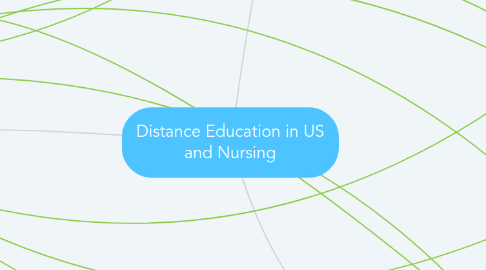
1. current state of distance education in higher ed
1.1. nursing education
1.2. staff development
1.3. development of evidence-base
1.4. the need for resources
2. terminology
2.1. correspondence course
2.1.1. a course of study in which teachers and students communicate via mail
2.2. online education
2.2.1. a form of education delivered and administered using the internet
2.3. distance education - education that uses one or more of the following technologies
2.3.1. internet
2.3.2. one-way or two way transmissions through open broadcast, closed circuit, cable, microwave, broadband lines, fiber optics, satellite, or wireless communications devices
2.3.3. audio conferencing
2.3.4. video cassettes, DVDs and CD-ROMS, if the cassettes, DVDs or CD-ROMS are used in course in conjunction with any of the above options
3. accreditation
3.1. NLN CNEA
3.1.1. culture of excellence - program outcomes
3.1.2. culture of integrity and accountability - mission, governance and resources
3.1.3. culture of excellence and caring - faculty
3.1.4. culture of excellence and caring - students
3.1.5. culture of learning and diversity - curriculum and evaluation
3.2. CCNE
3.2.1. 1. Foster trust in the process, in CCNE, and in the professional community.
3.2.2. 2. Focus on stimulating and supporting continuous quality improvement in nursing programs and their outcomes.
3.2.3. 3. Be inclusive in the implementation of its activities and maintain openness to the diverse institutional and individual issues and opinions of the community of interest.
3.2.4. 4. Rely on review and oversight by peers from the community of interest.
3.2.5. 5. Maintain integrity through a consistent, fair, and honest accreditation process.
3.2.6. 6. Value and foster innovation in both the accreditation process and the programs to be accredited.
3.2.7. 7. Facilitate and engage in self-assessment.
3.2.8. 8. Foster an educational climate that supports program students, graduates, and faculty in their pursuit of life-long learning.
3.2.9. 9. Maintain a high level of accountability to the publics served by the process, including consumers, students, employers, programs, and institutions of higher education.
3.2.10. 10. Maintain a process that is both cost-effective and cost-accountable.
3.2.11. 11. Encourage programs to develop graduates who are effective professionals and socially responsible citizens.
3.2.12. 12. Provide autonomy and procedural fairness in its deliberations and decision-making processes.

